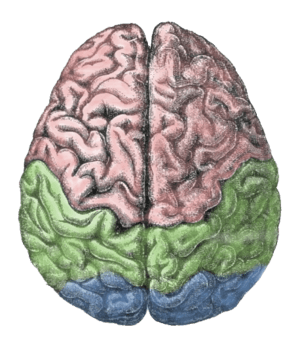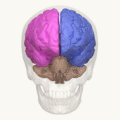Lateralization of brain function facts for kids
Your brain has two main parts, called the left and right hemispheres. These two halves are not exactly the same. For most jobs, both sides of your brain work together. But each side is better at certain tasks. This idea, that the different halves of your brain do things differently, is called brain lateralization.
Contents
The Brain's Halves
A deep groove splits your brain into its two halves. These halves are connected by the corpus callosum. This is a thick band of nerve fibers. The corpus callosum lets the left and right halves talk to each other. This helps them work together.
Both the left and right hemispheres look and work in similar ways. The big parts of both halves are the same. But in the smaller parts, there can be some differences.
Sometimes, a person's brain is different if they are left-handed or right-handed. For example, two brain areas are key for speech. These are Broca's area and Wernicke's area. For about 95% of right-handed people, these areas are in the left half. But for left-handed people, only about 70% have them in the left half.
Common Brain Myths
You might hear that each side of the brain does things the other side does not. For example, a common myth says the left brain does all "logical thinking." This includes things like solving math problems. The myth says the right brain does all "creative thinking." This includes painting or drawing. People might even say a creative person is "right-brained." They might say a logical person is "left-brained."
The truth is, both halves work together for logical and creative thinking. However, each half does specialize a bit. The right side of the brain often helps more with creativity. It also helps with understanding space and enjoying music. The left side of the brain usually helps more with thinking, language, and logic.
How Brain Sides Specialize
Both halves of your brain work together for most tasks. But for some jobs, one half might be more "dominant." This means it works harder than the other. For example, in about 95% of right-handed people, the left half is dominant for language. This means their language skills are mostly controlled by the left half. The right half helps, but not as much.
Language Skills
Important parts of language, like grammar and vocabulary, are usually handled by the left half. This means most thinking about grammar and words happens in the left brain. This is especially true for right-handed people.
Not all parts of language are mostly controlled by the left half. Other key parts of language are often handled by the right half. These include intonation (how words are said) and accentuation (which words are stressed).
Producing language, like writing or speaking, can be different for left-handed people. For about 90% of right-handed people, language production is in the left half. But for about half of left-handed people, both halves control language production. Or, it is mostly controlled by the right half.
Other Examples
- Understanding what we see and hear, recognizing faces, and artistic ability use both halves. But the right half might be more dominant. It might work harder at these tasks.
- Important parts of math, like estimating and comparing numbers, use both halves. But getting exact answers for math problems is mostly a job for the left half. If the left half is damaged, it can cause dyscalculia. This is trouble learning math and working with numbers.
- Remembering facts is mostly handled by the left half.
- Some people with depression have a right half that is too active. This means:
- The right half is working too hard on negative thoughts and feelings like sadness.
- The left half is not working hard enough on good feelings and experiences.
Brain Injuries
Sometimes, people have brain injuries that hurt a part of the brain. With very bad injuries, a whole half of the brain might be damaged. Sometimes, the other half can take over the damaged half's jobs. But this is not always possible. It depends on the damaged area and the person's age.
Sometimes, a brain injury damages pathways that carry information. In some people, the brain can create new, less direct pathways. These new "detours" can help the brain keep sending information. This happens between areas that were separated by the injury.
Related pages
Images for kids






